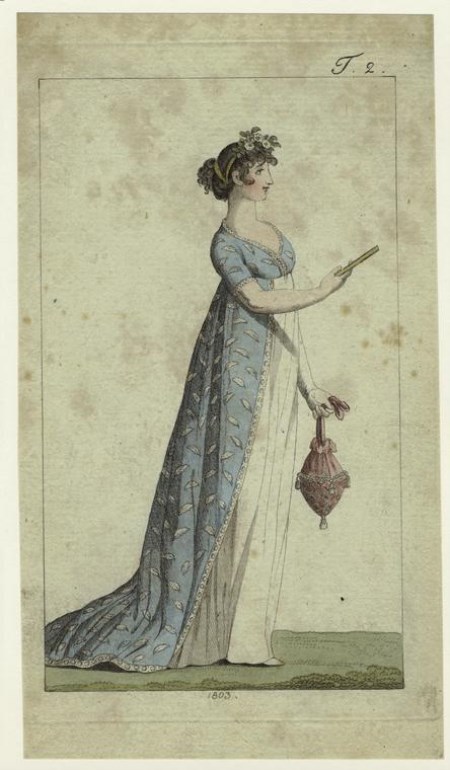
Woman holding a purse in one hand, circa 1803 (France)
The Miriam and Ira D. Wallach Division Of Art,
Prints And Photographs: Picture Collection, New York Public Library
Reticules were small drawstring bags used by Victorian women to hold necessary objects such as calling cards, money, and toiletries. These small bags were the first kind of handheld purse designed for women. Reticules are beautiful examples of the artistic handiwork at the time.
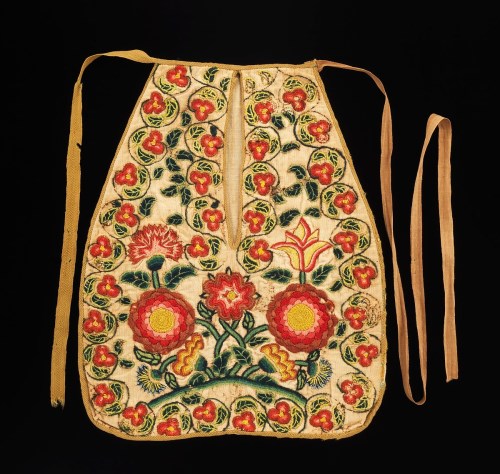
Pocket, circa 1784 (America)
Brooklyn Museum Costume Collection at The Metropolitan Museum of Art,
Gift of the Brooklyn Museum, 2009; Bequest of Marie Bernice Bitzer, by exchange, 1996
Before the reticule was popularized, women tied pockets around their waists under their petticoats to carry belongings. The side seams of the dress were open, and the wearer could slip her hand through the layers of fabric to access the pockets. To learn more about the history of pockets, the Victoria and Albert Museum has a very interesting article on the subject.
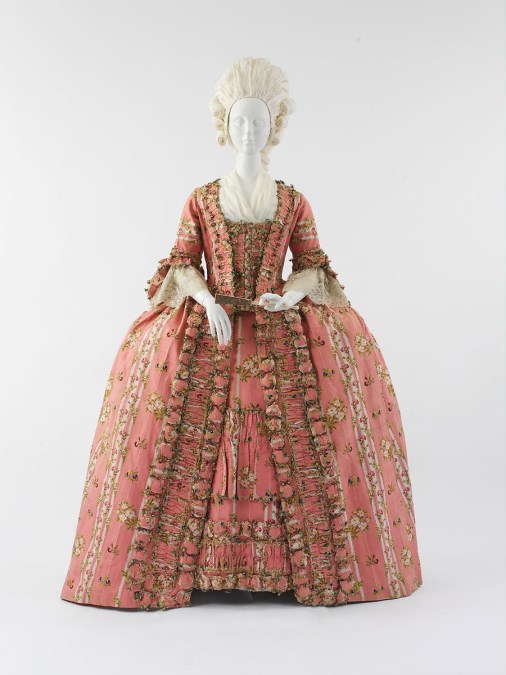
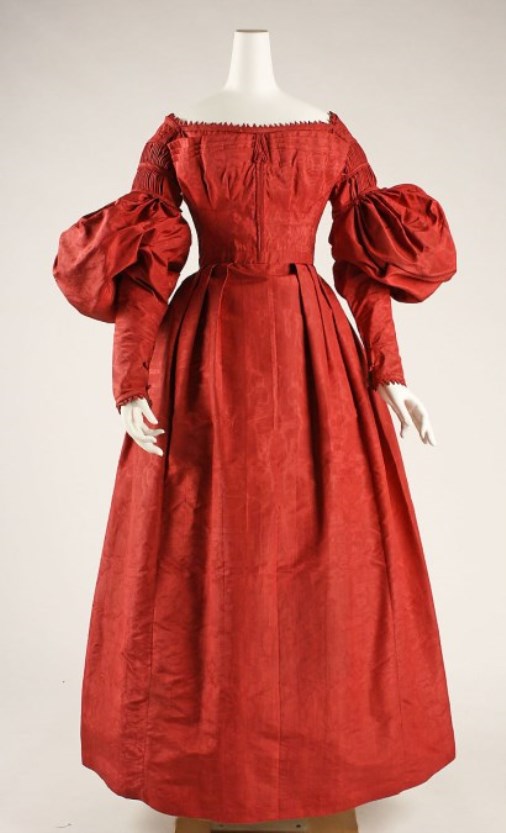
Above: Dress, circa 1775 (French)
The Metropolitan Museum of Art, New York, Isabel Shults Fund, 2005
Below: Dress, circa 1837 (American)
The Metropolitan Museum of Art, New York, Rogers Fund, 1937
At the end of the 18th century, female fashion changed dramatically. The large, layered skirts went out of style and a slender dress silhouette became popular. As a result, women carried drawstring pouches that functioned as an exterior pocket. Decorative reticules often complemented the wearer’s dress.
Decorative reticules carried an assortment of essential objects for daily social activities. Such items may have included:
- Brooch
- Calling Cards
- Change Purse
- Coins
- Comb
- Earrings
- Gloves
- Hairpins
- Handkerchief
- Mirror
- Necklace
- Patch Box
- Pocket Watch
- Ring
- Scent Bottle
- Smelling Salts
Early 19th century male critics ridiculed the reticule, claiming that women would overstuff the bags, which were meant to be small and delicate.
The reticules featured in this exhibit are from the Belleville area, dating between 1890 and 1930. They are part of Glanmore's Regional Collection. Many artifacts from Glanmore's collections can be discovered on the online artifact database.
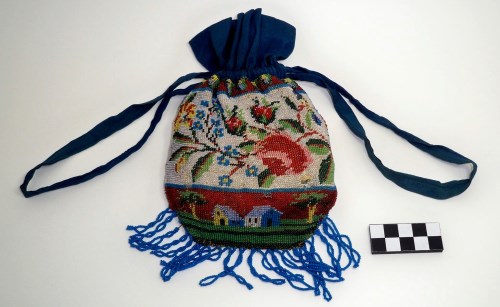
Reticule, circa 1890
This reticule is hand beaded on two layers of blue silk. The beadwork designs show multi-coloured images of flowers and a scene of houses and trees. There are blue beaded tassels at the bottom and a classic drawstring closure at the top.
Many reticules feature glass or steel beadwork. Reticules were commonly made of velvet, satin or silk in square or tulip-shapes. They were often handmade by fashionable women to display their handiwork.
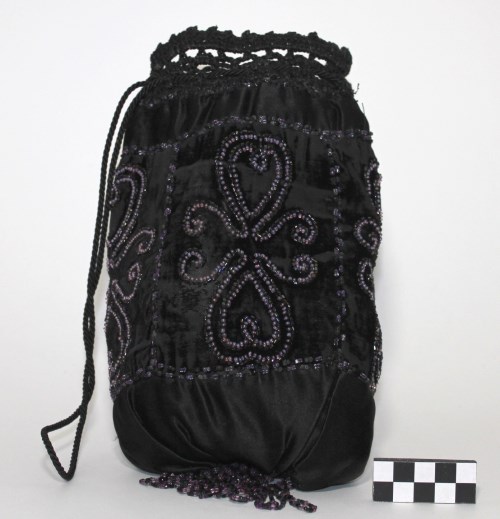
Reticule, circa 1890
This reticule is made of black satin and velvet. There is purple beadwork across the middle section, with crocheted lace at the top and a beaded tassel at the bottom.
“Most late-twentieth-century women would have felt lost without a handbag, that valuable accessory in which a woman carried all the paraphernalia seemingly indispensable to her daily life.” - Eleanor Johnson, Ladies’ Dress Accessories
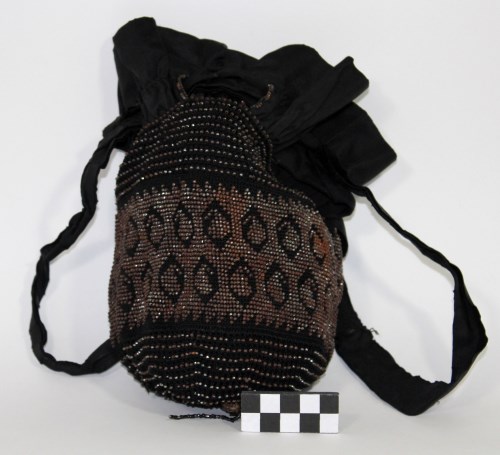
Reticule, circa 1890
This black satin reticule is decorated with artistic silver metal beadwork. It was crafted by a local dressmaker and milliner (someone who makes or sells hats). The term “reticule” comes from French and Latin terms meaning “net.” At the time, the word “purse” referred to small leather pouches used for carrying money.
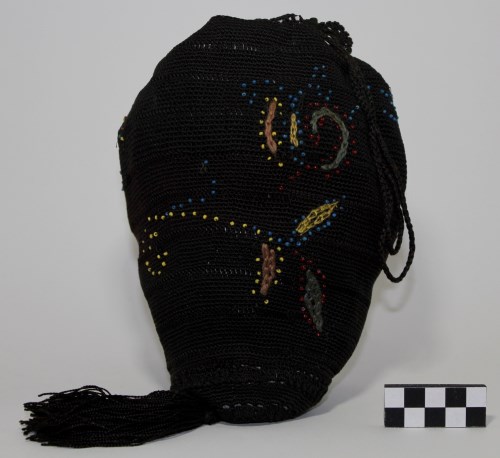
Reticule, circa 1890 – 1910
This black crocheted reticule has a multi-coloured beaded pattern around the top and middle sections. It has a scalloped trim along the top drawstring closure and a long tassel at the bottom. The earliest reticules were made of simple netting before later shifting to crochet, fabrics, and embellished beading.
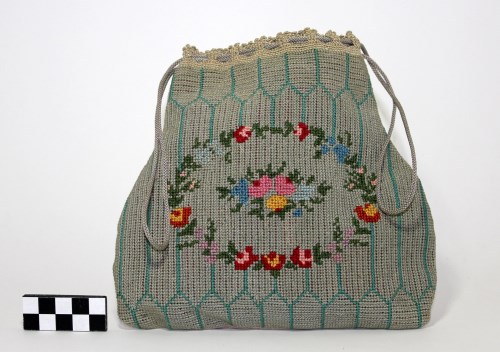
Reticule, circa 1890 – 1920
This light blue reticule was crafted by needlepoint with a decorative multi-coloured floral design in the center. The back is lined with grey velvet, and the inside is lined with hot pink cotton fabric.
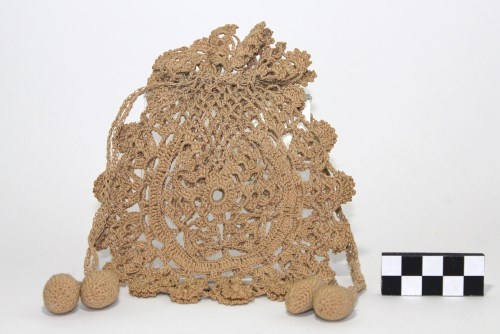
Reticule, circa 1890 -1920
This reticule is made entirely of brown crocheted lace. It is a circular style with scalloped edges and a drawstring closure at the top. The drawstrings have two round crocheted bobbles at the end, which was common for reticules of this style.
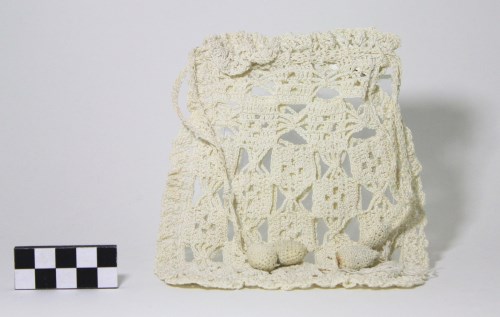
Reticule, circa 1900
This reticule is made of white crocheted lace with diamond shaped designs and round bobbles on the ends of the drawstrings.
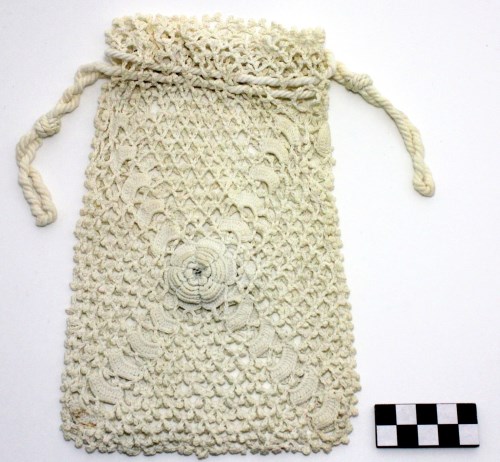
Reticule, circa 1910
This white crocheted lace reticule is decorated with a central rosette and an intercepting ‘X’ pattern.
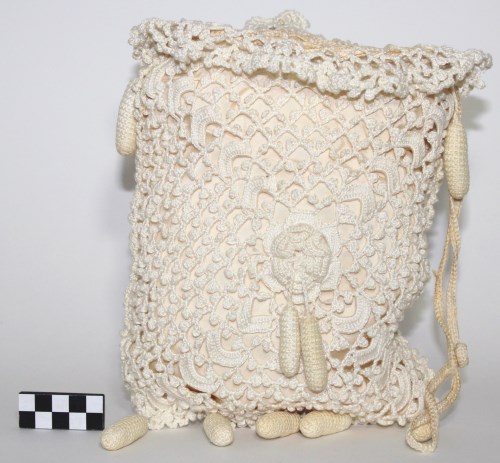
Reticule, circa 1910
This white crocheted reticule is decorated with rosettes and cone shaped tassels. It is lined with cotton fabric and has a classic drawstring closure at the top.
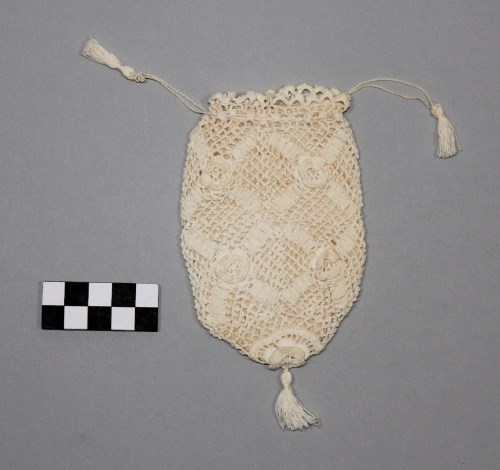
Reticule, circa 1900 – 1920
This ivory coloured reticule is a classic change purse style and is lined with cotton. The crocheted lace reticule has a diagonal geometric pattern, rosettes and a scalloped edge at the top.
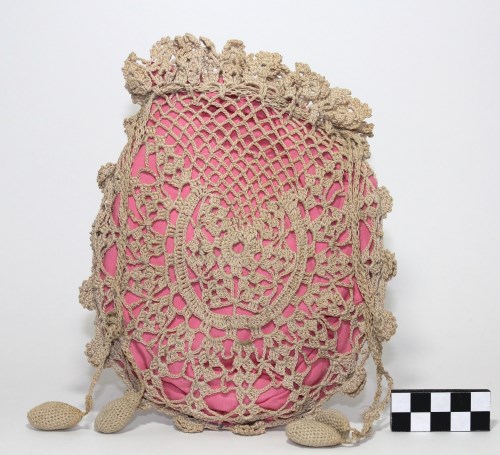
Reticule, circa 1900 – 1920
This reticule is made of crocheted off-white cotton lace and has a pink cotton lining. The edging is scalloped and the lace features a ‘V’ shaped pattern surrounded by floral designs. The drawstring features round crocheted bobbles at the ends.
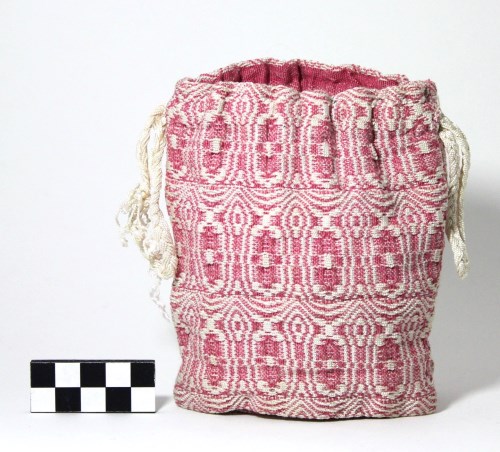
Reticule, circa 1900 – 1920
This reticule is made of pink and white woven cotton fabric, is lined with silk and has a classic drawstring closure.
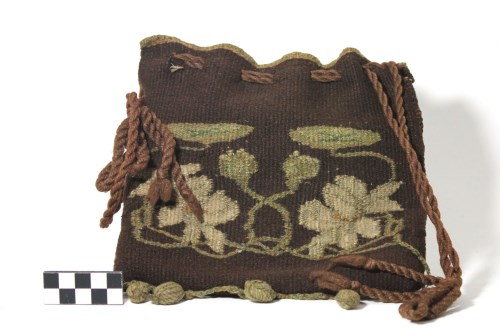
Reticule, circa 1900 – 1920
This reticule is made of brown woven wool with a floral and leaf design on the front and back. There are four small bobble tassels hanging from the bottom and there is a drawstring closure at the top.
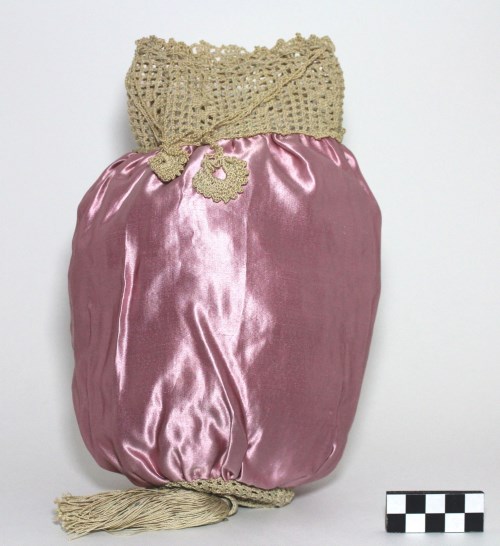
Reticule, circa 1900 – 1920
This reticule is made of vibrant pink satin. There is crocheted lace at the top near the drawstrings and at the bottom above the tassel.
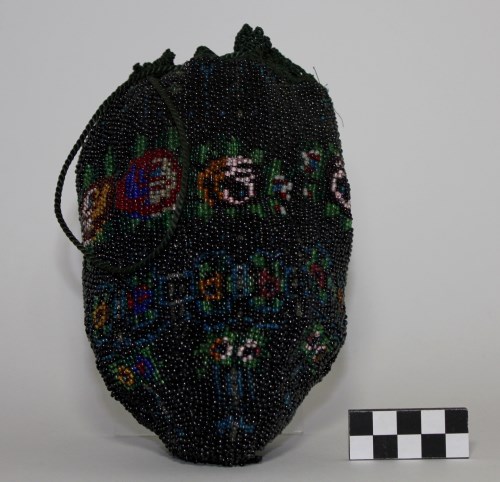
Reticule, circa 1900 – 1920
This reticule is entirely beaded with multi-coloured floral patterns on a black background and a drawstring closure at the top.
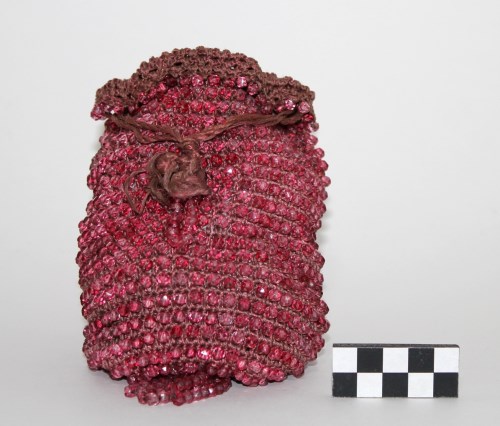
Reticule, circa 1900 – 1920
This reticule is made of cotton fabric that is entirely covered in pink glass beadwork. There are beaded tassels at the bottom and pink crocheted lace at the top near the drawstrings.
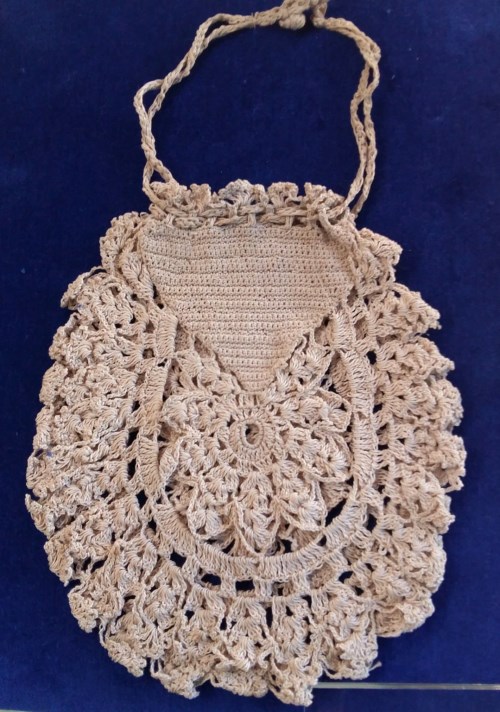
Reticule, circa 1920
This off-white reticule was hand crocheted by Grace Morton (1907-2008) who wrote many poems about her life in Hastings County. It has a floral pattern with a ‘V’ shaped pattern pointing downward to the center.
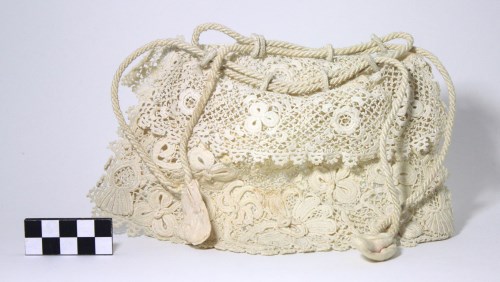
Reticule, circa 1920 – 1930
This unusually shaped reticule has five sides and is made entirely of white floral patterned lace.
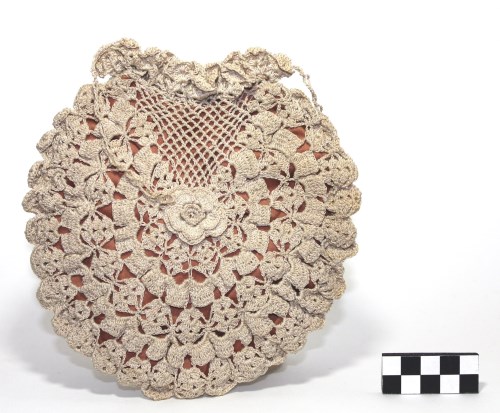
Reticule, circa 1920
This off-white crocheted lace reticule is decorated with a rosette pattern and is lined with rust coloured cotton fabric.

